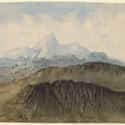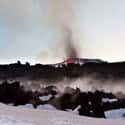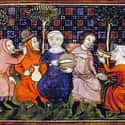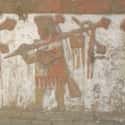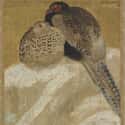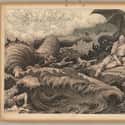-
(#8) Subsequent Volcanic Eruptions Only Made Things Worse
Volcanic eruptions in Iceland in 540 and 547 contributed to the general darkness of the time. The three eruptions together led to what scholars termed the Late Antique Little Ice Age. This Little Ice Age cooled the planet for at least a decade, if not longer. The result was crop failure and starvation, which led to increasingly unhealthy populations susceptible to illness.
Based on tropical volcanic ash discovered in both northern and southern ice cores, some scholars posited a volcano in El Salvador in 535 or 536 kicked off the Little Ice Age. Near San Salvador, the Ilopango volcano - now a crater lake - erupted during the mid-6th century as well. The eruption coincided with the "Hiatus" period of the Mayan Empire, during which time the population and construction activity declined. Others believed the eruption of volcanoes in North America during the 530s brought on the massive cloud that hung in the skies over Northern and Western Europe.
Even if the Ilopango eruption, a North American volcano, or any other volcanic event was not singularly massive enough to blanket the Western hemisphere with ash, the events contributed to the overall darkness of mid-6th century.
-
(#11) A Group Of Scholars Analyzed The Evidence In 2018
The horrible conditions described by contemporaries in 536 received new attention in 2018. Harvard historian Michael McCormick was among the interdisciplinary group of scholars who pooled their research to determine whether 536 was truly the worst year ever. However, the group started its research with a different goal in mind. Rather, the 12 academics wanted answers about metal usage, coinage, and changes to 7th-century monetary systems. Their investigation happened to include analysis of glaciers in the Swiss Alps to find out what brought on an extended period of darkness that lasted for 18 months during the mid-6th century.
Through unprecedented technological research, a team of professors found volcanic tephra (volcanic fragments) from an Icelandic volcano in ice core samples from Swiss glaciers. Coincidentally, the samples dated back to 536. This confirmed a volcanic event that shot ash through the Northern European atmosphere and spread around the world, triggering a global crisis.
-
(#6) Irish Chroniclers Describe Widespread Bread Shortages
Monks in Ireland during the 6th century took notice of the crop failures around them. The monastic tradition in Ireland, later dubbed Celtic monasticism, exhibited a love of scholarship. This prompted monks to not only copy existing manuscripts and preserve learning, but also keep records of the world around them. The unknown author of the Annals of Ulster recorded a "failure of bread" in 536, and his counterpart at Inisfallen indicated bread shortages from 536 to 539.
Ulster, in the northern part of Ireland, and Inisfallen, located in the south, were both in proximity to Iceland, where some experts posit a volcano triggered the fog of 536.
-
(#10) The Peruvian Moche Civilization Reportedly Suffered In 536 As Well
The Moche civilization once dominated the western coast of South American, contributing to the cultural and economic heritage of the region. The Moche were avid fishermen and mastered irrigation to grow various crops, including beans and corn.
Agricultural commerce supported settlements like civilization's namesake, Moche, but an El Niño cycle in the mid-6th century caused waters so warm that fish populations could not sustain life. Massive floods and heavy rains destroyed irrigation networks, making it impossible to grow enough food to feed the population. Famine and climate chaos combined with ineffective leadership and the Moche never again achieved their earlier strength.
Initially, historians believed the El Niño, sometimes referred to as a "Super El Niño," could have been kicked off by a volcanic eruption, most likely Krakatoa in Indonesia.
-
(#4) Summer Snow Reportedly Fell In China And Mesopotamia
Around 536, the climate in China underwent some odd changes of its own. The Nan Shi, a 6th-century chronicle, reported a yellow ash-like substance falling from the sky. The exact composition of the material remains unclear, but accounts describe it as dirt or dust that could be "scooped up in handfuls." The substance appeared three times during the late 530s.
The following year, Chinese chronicles indicated snow during the summer months. The Chronicles of the Southern Dynasties reported frost in mid-summer with snow in August, which ruined crops in Qingzhou and other provinces. The result was widespread famine that lasted for about two years and resulted in a loss of roughly 70-80% of the population.
Additional reports of frost and snow in Mesopotamia also turned up during the summer of 536, and the winter was "a severe one, so much so that from the large and [unwanted] quantity of snow, the birds perished."
-
(#5) Scandinavians Abandoned Entire Cities
During the 6th century, villages in eastern and central parts of Sweden saw such decline that many cites were abandoned. The reason for this deserting remains somewhat unclear, but the "dust veil" of 536 and subsequent scarcity certainly influenced Scandinavians' actions.
Prior to the ice core evidence about the eruption of 536, theorists believe a possible meteor strike brought on such devastation. Additional evidence showed that village abandonment happened due to farmhouse fires, indicating relocation wasn't out of the question.
That said, a Norse legend called Fimbulwinter includes a three-year-long winter that occurred before Ragnorök, the end of the world also referred to as the Twilight of the Gods. It is possible the story of the extended winter became associated with the extended darkness present in this century.
New Random Displays Display All By Ranking
About This Tool
As we all know, thousands of people have been killed by COVID-19 in 2020, the wildfires in Australia lasted for several months and African locust plagues were raging. Many people believe that 2020 may be the worst year in human history. However, most historians agree the situation in 536 AD was worse than it is now. According to historical records and related research, the European volcanic eruption in 536 AD triggered chain reactions.
There was no sunlight for 18 months so that people could not distinguish between day and night, crops could not grow normally, and food production was reduced, which caused social chaos and a plague. The random tool shared 13 details about what happened in the worst year.
Our data comes from Ranker, If you want to participate in the ranking of items displayed on this page, please click here.











